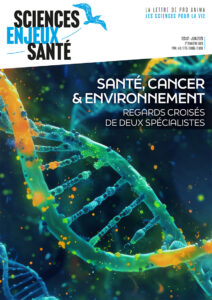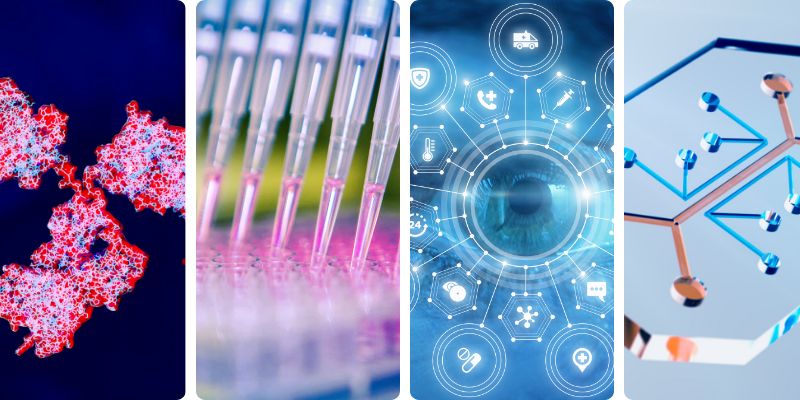
Childhood cancer treatment at Gustave Roussy, CEA TOXBOX, Human tissues sourcing services, Xeno-Free 3D Bioprinted Liver Model and more
News on non-animal methods
FEB. 19 - 23, 2024NEWS, REPORTS & POSITION STATEMENTS
1. From the laboratory to clinical trials, Gustave Roussy continues its drive to cure childhood cancer in the 21st century
Every year in France, 2,200 children and adolescents learn that they have cancer. Multiple and different from adult cancers, pediatric cancers require rapid diagnosis and appropriate care by highly specialized teams. Despite advances, treatment still proves ineffective for 20% of young patients, and those cured sometimes suffer significant after-effects throughout their lives.
The GOBT Lab research team at Gustave Roussy that cured Lucas (13 yo), who had a brainstem glioma, uses brain organoids to understand the mechanisms of glioma carcinogenesis, analyse genetic factors and assess the potential of new molecules in the laboratory, including new immunotherapies in very early development in adults, before administering them to young patients. A feel-good success story full of hope for the future of cancer treatment and a superb example of the use of non-animal methods for scientific research and personalised medicine.
Deployed at Gustave Roussy from 2019, CAR‑T cell therapy is a revolution in the treatment of acute lymphoblastic leukaemia in children and young adults. CAR‑T cells are T lymphocytes that have been genetically modified to recognise and eliminate cancer cells, before being reinjected into the patient. Professor Véronique Minard-Colin, paediatric oncologist at Gustave Roussy, reported the results of an international study at the European Haematology Congress, which also demonstrated the activity of CAR‑T cells in the treatment of relapsed paediatric lymphomas.
Read more (in French)
2. Incentivize alternatives to animal research from the ABA House
The ABA House of Delegates on Monday February 5th at the 2024 ABA Midyear Meeting in Louisville, Kentucky, adopted a resolution, Resolution 502, urging Congress and federal agencies to promote the development and use of methods that aim to replace, reduce and refine (3R) the use of animal models in research and testing.
The resolution focuses on removing barriers to and creating incentives for the use of non animal model research and testing methods in regulatory and federally sponsored research. The report accompanying the resolution says that encouraging “the replacement of animal-based research and testing with scientifically suitable, cost-effective and humane non-animal methods promotes just laws and the public good.”
3. NIST’s Heart-on-a-Chip : A Microfluidic Marvel Shaping the Future of Cardiovascular Research
Researchers at the National Institute of Standards and Technology (NIST) have developed a tool for building a system known as heart-on-a-chip (HoC). This technology seeks to address the limitations of conventional cardiovascular drug development, which relies heavily on animal testing.
Darwin Reyes, biomedical engineer in the Microsystems and Nanotechnology Division of the Physical Measurement Laboratory (PML) at NIST, brings insight and opinion on rethinking animal testing, and global collaboration for standardizing Organ-on-a-Chip technology :
- “The ultimate goal is to, if possible, be able to skip the animal testing altogether. This would also shorten the time it takes to test drugs, which would hopefully make the medications cost less.”
- “The more collaborative research there is outside of what is currently being done and where we’re heading, the better this technology is going to be” ;
As an active participant, along with scientific organizations across the globe, in developing standards for this technology, NIST contributes with its models in gaining regulatory approvals but also ensures better acceptance in the scientific, industrial and medical communities to usher in a new era of drug development.
INTERVIEWS, NOMINATIONS
4. BeCytes expert opinion : Tissue sourcing services to reduce research challenges
Access to biological samples for research represents a significant challenge for researchers today. This challenge is not related to the complexity of the regulatory and ethical framework governing access to biological samples but to the difficulty of obtaining quality human tissue with high viability criteria and associated clinical information in a standardized manner.
BeCytes interviewed his Technical Director, Estephan Arredondo, about the tissue-sourcing service, a solution to grant access to the scientific community to diverse tissues for research.
INDUSTRY, BIOTECH, PARTNERSHIPS
5. MITIEverse : A Metaverse for Medical Innovation
Virtual reality (VR) is taking the world by storm, and the Houston Methodist DeBakey Heart & Vascular Center — in partnership with the Houston Methodist Institute for Technology, Innovation & Education (MITIETM) — is leading the wave in the medical educational realm. MITIEverse, a metaverse for medical innovation, is an app that will eventually offer an endless supply of resources and experiences in health care education, training and innovation.
6. UK’s Newcells Biotech snaps £2.35M for its 3D alternative to animal testing
The use of non-animal testing methods is likely to increase as a result of recent changes to the FDA guidance which recognises that they can be suitable replacements for animal testing. Working on this segment is Newcastle-based Newcells Biotech.
Newcells Biotech builds functional in vitro models to improve clinical translation and drug discovery. The company, which develops its assays for drug and chemical discovery and development, has snapped a £2.35 million boost.
7. BIENCO awarded $35m to address global corneal blindness with tailored cost-effective bioengineered corneas
The Australian Government’s Medical Research Futures Fund (MRFF) has awarded $35 million to BIENCO, a world-first consortium of clinical, scientific and governance experts, to address the global challenge of corneal blindness, with the University of Wollongong (UOW) involved as a key partner.
BIENCO builds on UOW’s corneal research and will develop individually tailored cost-effective bioengineered corneas, capable of addressing global blindness by improving access to corneal grafts donated by deceased donors.
“We believe this is the largest grant in Australia’s history for eye research. This positions us as a global bioengineered tissue provider and is humbling recognition of the importance of our work and the advancements the BIENCO team have made.” said Professor Sutton, University of Sydney’s BIENCO lead and corneal specialist at the Save Sight Institute.
8. A unique ex-vivo research platform around human adipose tissue by Exadex-Innov
ExAdEx-Innov is a French biotechnology company specialising in applied research on human adipose tissue.They draw on more than 30 years of expertise and knowledge of adipose tissue to offer a unique technological platform for cosmetics, nutraceuticals and biomedical research, revealing the complex biology of human adipose tissue using innovative tools.
ExAdEx aims to be an R&D partner in the preclinical phases of assessing the toxicity and efficacy of new cosmetic and nutraceutical ingredients. Their 360° vision enables them to support ingredient developers in the design of the experimental phase, the selection of innovative biomarkers, the development of custom ex vivo models and analysis tools, and the interpretation of results.
TOOLS, PLATFORMS, GRANTS
9. Toxbox : A toxicology-testing platform integrating in vitro/ex vivo modules with in silico models for life cycle assessment and Safe and Sustainable by Design (SSbD)
There are major health and regulatory concerns about the potential toxicity of new chemicals and materials. In addition, safety assessment during the development of new chemicals still relies heavily on in vivo studies.
As presented in the Commission initiative for SSbD, the safety and sustainability assessment follows a step-wise approach, addressing hazard assessment, safety aspects of production and processing, human health, and eventually environmental sustainability assessment.
Funded by Horizon Europe, TOXBOX (2024 — 2027) aspires to bring forth an instrument that will provide reliable toxicity data in relevant conditions for each chemical and enable reliable in silico model development.
10. New opportunity for histology platforms to replace their animal-derived antibodies with recombinant alternatives : GIS FC3R and the French Association of Histotechnology (AFH) are joining forces
The use of antibodies produced in animals is still widespread, although it poses ethical and scientific robustness problems (Baker, 2015 ; Bradbury et al., 2015). There are more reliable and more economical recombinant alternatives (antibodies produced in vitro on sequence). Since 2020, the European (ECVAM) and French (CNREEA) regulatory authorities have recommended the replacement of antibodies of animal origin with recombinant alternatives.
If you are responsible for a histology platform and interested in participating in this pilot study funded by the French Center for the 3Rs (GIS FC3R) in 2024, you need to fill the questionnaire before 03/31/2024.
11. Cell-ID & MED-OOC : Two ambitious research projects at the Institut Curie among the latest exploratory PEPRs awarded
Exploratory Priority Research Programs and Equipment (PEPR) aim to support an emerging transformation, whether technological, economic, societal, health or environmental, and to support the exploration of its potential. They are selected by call for programs from the France 2030 investment plan launched by the National Research Agency — ANR, evaluated by an international jury and validated by the State.
A project, in which the Institut Curie plays a major role, has just been selected : Cell-ID, for cellular interception medicine. The institute will also lead a working group in a second PEPR, MED-OOC, for the development of a new generation of tumor-on-a-chip. Dr Geneviève Almouzni, head of the Chromatin Dynamics team at the Institut Curie, has been appointed CNRS director of the Cell-ID (or “Cellular Identities and Destiny”) program. Dr Stéphanie Descroix, head of the Macromolecules and microsystems team in biology and medicine at the Institut Curie, is also recognized for her contribution to the MED-OOC project.
12. A new machine learning tool identifies drugs to minimise fibrosis
The computer model enables a better understanding of how drugs affect fibroblasts and finds a promising candidate to prevent heart scarring.
A new approach to machine learning (ML) has been developed by researchers from the University of Virginia (UVA) to identify drugs that help minimise dangerous scarring following a heart attack or other injuries. Interestingly, the tool has found a promising candidate to help prevent heart scarring in a different way to previous drugs. The scientists state that their model could predict and explain the effects of drugs for other diseases as well.
SCIENTIFIC DISCOVERIES & PUBLICATIONS
13. Xeno-Free 3D Bioprinted Liver Model for Hepatotoxicity Assessment
Three-dimensional (3D) bioprinting is one of the most promising methodologies that are currently in development for the replacement of animal experiments. Bioprinting and most alternative technologies rely on animal-derived materials, which compromises the intent of animal welfare and results in the generation of chimeric systems of limited value.
A new study therefore presents the first bioprinted liver model that is entirely void of animal-derived constituents. The established xeno-free model was used for toxicity testing of a marine biotoxin, okadaic acid (OA). In 2D culture, OA toxicity was virtually identical for cells cultured under standard conditions and in chemically defined medium (CDM). In the xeno-free bioprinted liver model, 3‑fold higher concentrations of OA than in the respective monolayer culture were needed to induce cytotoxicity.
This study describes for the first time the development of a xeno-free 3D bioprinted liver model and its applicability for research purposes.
14. Michigan State University (MSU) researchers create more realistic synthetic human “mini hearts”
Thanks to advancements in the development of patented synthetic human-like hearts first created at Michigan State, researchers can study human heart development and congenital heart disease on highly accurate models. This is facilitating the development of new therapies and pharmaceutical drugs to treat a variety of heart-related diseases just in time for the observance of American Heart Month in February.
Aitor Aguirre, associate professor of biomedical engineering and chief of the division of developmental and stem cell biology in MSU’s Institute for Quantitative Health Science and Engineering, said : ““We created a model using [heart] organoids to study the effects of maternal diabetes at every stage of development in the fetal heart. This is the definition of precision medicine. We can use science to make clinical practice more precise.””.
UPCOMING WEBINARS, WORKSHOPS, SYMPOSIA
Check out our events interface


